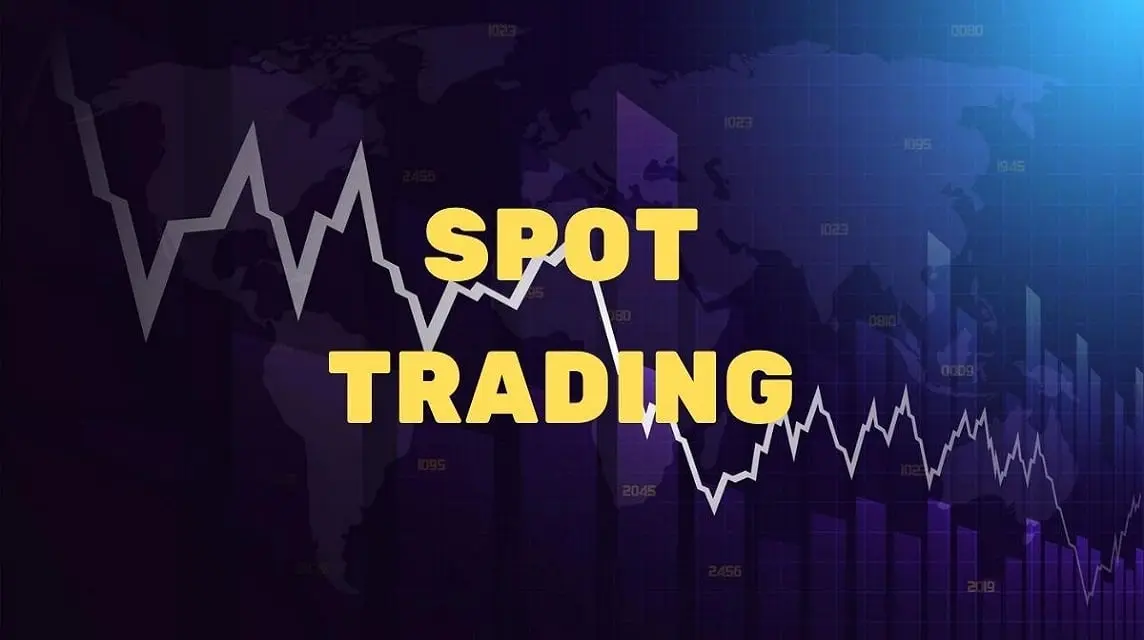Crypto Spot Trading vs Futures Trading: Difference & Similarities
Written by Michael Hayes
Michael Hayes, a seasoned finance professional, enhanced his expertise by attending executive education programs in Finance at the prestigious Wharton School of the University of Pennsylvania. With a career spanning over 20 years, Michael has gained extensive experience in financial analysis, investment management, and strategic financial planning. His deep understanding of financial markets, coupled with his passion for continuous learning, has made him a trusted advisor in the field
Expert Reviewed
This article has been reviewed by crypto market experts at SCM to ensure all the content, sources, and claims adhere to the highest standards of accuracy and reliability.
Last Updated on July 4, 2025
Spot trading in cryptocurrency allows you to buy and sell digital assets based on their current market price for immediate delivery.
- Definition and Mechanics of Spot Trading in Crypto
In spot trading, you execute transactions at the prevailing market price. When you place a buy or sell order, it is matched with an existing order on an exchange platform, and the trade is completed instantly.
- Immediate Delivery of Cryptocurrencies
As the name suggests, “on the spot” implies that the exchange of assets happens immediately. When you purchase cryptocurrencies in a spot trade, the digital assets are transferred to your wallet immediately, typically within minutes after the trade execution.
- Ownership and Rights Associated With Spot Trading
You gain full ownership when you engage in spot trading and acquire a cryptocurrency.
This means you can transfer, exchange, or use the asset as you see fit. Unlike derivatives, there’s no expiration or obligation to sell the asset at a future date.
- Examples of Spot Trading on Exchanges
Famous examples of spot trading can be seen on cryptocurrency exchanges such as Binance or Coinbase.
Here, you can select a pairing, BTC/USD, and purchase Bitcoin with US dollars at the current market price, resulting in immediate ownership of Bitcoin in your digital wallet.
What Is Futures Trading in Crypto?
Futures trading is a forward-looking strategy that allows you to hedge positions or speculate on a cryptocurrency’s future price.
- Definition and Mechanics of Futures Trading in Crypto
In the crypto markets, futures trading refers to a contractual agreement to buy or sell a specific cryptocurrency at a predetermined price at a set date in the future.
Unlike spot trading, where you exchange assets immediately, futures are concerned with transactions that will occur later. When you enter a futures contract, you are not trading the crypto asset directly but rather a contract representing the asset.
- Trading Contracts for Future Delivery
These contracts obligate you to transact the specified amount of cryptocurrency at the agreed-upon price, regardless of the current market price at the contract’s execution date. Your potential gain or loss hinges on the accuracy of your predictions about the asset’s future value.
- Leverage and Margin in Futures Trading
Futures trading often involves leverage, which means you can control a substantial position using only a fraction of its total value, known as “margin.” Leverage amplifies profits and losses, making futures trading potentially more lucrative and riskier than in the spot market.
- Examples of Futures Contracts on Crypto Exchanges
Leading crypto exchanges offer a variety of futures products.
For example, you might see a futures contract specifying the quantity of Bitcoin to be exchanged, the future date, and the price. If the market price on the delivery date is higher than your contract price, you profit; if it’s lower, you incur a loss.
Spot Trading vs Futures Trading in Crypto?
In exploring the distinction between spot and futures trading in the cryptocurrency market, you’ll encounter fundamental differences regarding asset ownership, settlement times, risk-reward dynamics, and practical applications.
- Ownership of the Asset vs. Contracts
In spot trading, you acquire ownership of the cryptocurrency the moment you purchase it.
You exchange fiat currency or another crypto for the total amount of the asset at its current market price.
Conversely, futures trading involves buying or selling contracts that represent the obligation to purchase or sell the crypto at a predetermined future date and price.
- Settlement Times: Immediate vs. Future Date
Spot trades are settled immediately, meaning the asset transfer and Payment occur on the spot, often within a short time frame.
With futures trading, the settlement is on a specified date, as the contract outlines. You’re committing to a price and transaction later, independent of the asset’s price at trade execution.
- Risk and Reward Profiles
The risk in spot trading is typically lower, as there’s no leverage involved—you’re only risking the capital you’re using to buy the assets.
Futures trading, however, can involve high leverage levels, allowing you to control prominent positions with a smaller amount of capital, amplifying potential profits and losses.
- Use Cases for Each Type of Trading
Spot trading is well-suited for those planning to hold cryptocurrencies as a long-term investment or use them for purchases or transfers.
Futures trading is often favored by those looking to hedge against price volatility or speculate on price movements without needing to hold the actual currency due to the ability to leverage and potentially profit from markets moving in either direction.
Advantages & Disadvantages Of Crypto Spot & Futures Trading
In this section, you will explore the benefits and drawbacks of spot and futures trading in the cryptocurrency market.
Understanding these can empower you to make informed decisions based on your investment strategy, risk tolerance, and financial goals.
Pros and Cons of Spot Trading
- Pros:
- Immediate Ownership: When you execute a spot trade, you gain ownership of the cryptocurrency immediately, allowing you to use or hold the asset as you see fit.
- No Leverage: Spot trading typically involves no leverage, meaning amplified losses are less risky.
- Cons:
- Full Payment Required: You must pay the total market price for the cryptocurrency upfront when you make a spot trade.
- Market Volatility: CryPaymentencies are known for their volatility, which can lead to significant price fluctuations in the spot market.
Pros and Cons of Futures Trading
- Pros:
- Leverage: Futures trading allows you to control a more prominent position with less capital, potentially increasing your profits.
- Strategic Advantages: Hedge against market volatility or speculate on future price movements.
- Cons:
- Complexity: Requires a more sophisticated understanding of the markets and derivative instruments.
- Risk of Leverage: While leverage can amplify profits, it can also magnify losses, sometimes exceeding the initial investment.
Comparative Analysis on Liquidity, Volatility, and Regulatory Aspects
- Liquidity: Spot markets are generally highly liquid, especially for popular cryptocurrencies. Futures markets also offer liquidity but can vary depending on the contract and exchange.
- Volatility: Both markets are subject to volatility; however, futures allow for better hedging strategies, which can help manage this volatility.
- Regulatory Aspects: Futures trading is typically subject to more stringent regulatory oversight than spot trading, which can provide a more structured trading environment but may also introduce restrictions.
Choosing Between Spot and Futures Trading
Understanding the differences between spot and futures trading is crucial for aligning with your financial goals and risk strategy when deciding to trade cryptocurrencies.
- Market Conditions: In spot trading, you purchase or sell cryptocurrencies immediately at their current market prices, which is beneficial in stable or bullish markets. Futures trading, conversely, allows you to speculate on the future price of a crypto asset, which can be advantageous in volatile or bearish conditions.
- Liquidity and Time Frame: Spot markets typically offer higher liquidity, making entering or exiting trades easier. Futures markets might have longer-term contracts that require a longer investment horizon.
- Capital and Leverage: Futures trading often provides access to higher leverage, which means you can open a more prominent position with less capital. However, this also increases both the potential gains and losses.
Profile of Traders Who May Prefer Each Type
Spot Traders: You might prefer spot trading if:
- You seek ownership of the actual cryptocurrency.
- You plan to hold your assets long-term, potentially to utilize them in transactions.
Futures Traders: You may lean towards futures trading if:
- You are experienced in predicting market trends.
- You prefer to trade on the price movements without holding the underlying asset.
Strategies for Managing Risks in Both Markets
Spot Trading:
- Utilize stop-loss orders to limit potential losses.
- Diversify your portfolio to mitigate the risk of price volatility.
Futures Trading:
- Regularly monitor margin requirements to maintain your positions.
- Employ hedging strategies by taking an opposite position in the spot market to balance potential futures market losses.
Frequently Asked Questions
This section addresses common inquiries regarding the differences and considerations between crypto spot trading and futures trading, offering you clear insights for informed decision-making.
Which is more suitable for beginners: spot trading or futures trading?
Spot trading is considered more suitable if you are new to cryptocurrency trading. It involves direct purchases of cryptocurrencies for immediate ownership, making it simpler and less risky than futures trading.
How does liquidity compare between spot and futures markets in crypto?
Liquidity in spot markets for cryptocurrencies tends to be high, as they are immediate transactions. However, futures markets can also offer considerable liquidity due to the high volumes traded by speculators and investors managing risk.
What are the relative risks of spot trading versus futures trading in the crypto market?
Spot trading carries lower risk as it lacks leverage and involves owning the asset outright. Futures trading, conversely, involves leverage, which can amplify gains and losses, thus carrying higher risk.
How do spot and futures trading volumes in Bitcoin impact the overall market?
Spot and futures trading volumes in Bitcoin can indicate market sentiment. High futures volume might reflect hedging or speculative activities, while high spot volume might indicate strong buying or selling interest, influencing Bitcoin’s price volatility.
Is crypto spot trading profitable?
Crypto spot trading can be profitable if you accurately predict market movements. Since spot trading does not use leverage, profits are based on the total value of the held asset without multiplied risk.
Spot trading vs. futures trading crypto price?
In spot trading, you pay the current market price of the cryptocurrency. Futures trading involves agreements on future prices, which can differ from the spot price, allowing for speculation on price movements.
Conclusion
When comparing Spot and Futures trading in cryptocurrency, your strategy should align with your financial goals, risk tolerance, and market knowledge.
Spot trading offers immediate asset ownership, with the advantage of paying the full price upfront, avoiding leverage risks.
Spot Trading:
- Total Payment: Paid in full at the transaction time.
- Asset Ownership: Immediate ownership of the cryptocurrency.
- No Leverage: Reduces exposure to market fluctuations.
Futures trading allows speculation on future prices with leverage, potentially increasing profits. However, careful planning is needed to manage contract expiration dates and avoid unwanted asset delivery.
Futures Trading:
- Leverage: Control larger positions with a smaller investment.
- Speculation on Prices: Profit from predicting future values.
- Expiration Dates: Be aware of contract settlement or rollover dates.
Leverage in futures trading can magnify both gains and losses, requiring a deeper understanding of market dynamics and higher risk tolerance.
Choose between spot and futures trading based on your experience and comfort with market exposure, and consider professional advice to navigate the crypto market effectively, ensuring your approach aligns with your investment strategy.




